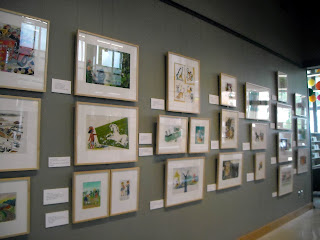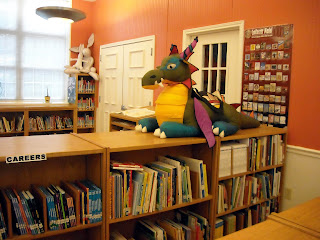You must read the above post and view the pictures of the massive library. Great news isn’t it?
Golden Books Legacy Exhibit
 |
| Golden Books Legacy Exhibit |
“I hope to say to all children that they are special…that all of us are special…important just because we are ourselves.” – Patricia Reilly Giff
Author of the Month Radio Interview
I was honored to be featured as Arte Publico Press’ Author of the Month and interviewed by producer Eric Ladau on the Public Radio Houston Affiliate station, KUHA-FM, Classical91.7. To listen to the interview online, click on KUHA’s web site above. I hope you enjoy it.
 |
| Trolley |
Children’s Writers’ Resources
 |
| A Pinata Workshop |
“What makes children a uniquely satisfying audience is that they choose their favorite writers uninfluenced by trends or fashions.” – Connie Epstein
Creating Mystery Novels
 |
| Spooky, huh? |
Once upon a time …
#4: Once upon a time there was ___. Every day, ___. One day ___. Because of that, ___. Because of that, ___. Until finally ___.
#9: When you’re stuck, make a list of what WOULDN’T happen next. Lots of times the material to get you unstuck will show up.
#14: Why must you tell THIS story? What’s the belief burning within you that your story feeds off of? That’s the heart of it.
 |
| School Visit |
Sheer joy of reading
“A journal can be an invaluable tool for recording ideas, impressions, and anecdotes for future use. It can also help your career by instilling in you the habit of writing regularly.” –Writer’s Digest Weekly Planner
Social Media
| Santa Fe |
I have a better understanding of what social media is all about, the pros and cons, and now it’s up to me to decide which way to go with it. For more on this topic, visit Pincus’ blog, The Happy Accident.
Writing a Synopsis
However, do not despair. There’s help. Everywhere. Here’s only one link that you might be interested in that focuses on this topic. “Writing a Synopsis from the Ground Up,” by Dee-Ann Latona LeBlanc is pretty interesting because she uses “a sequence of synopses in the following sizes:
- A single sentence.
- A single paragraph.
- A single page or shorter.
- The expanded version.”
LeBlanc’s article is very helpful.
 |
| Aguas Frescas |
Never try to chase trends. Write what you love, and write the best book you can, and worry about publication later.” – Writer’s Digest Weekly Planner
Book Signing Success
 |
| Book Signing |



